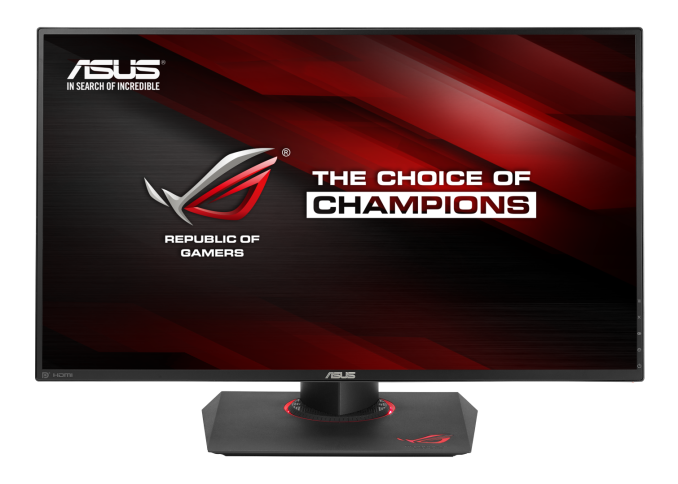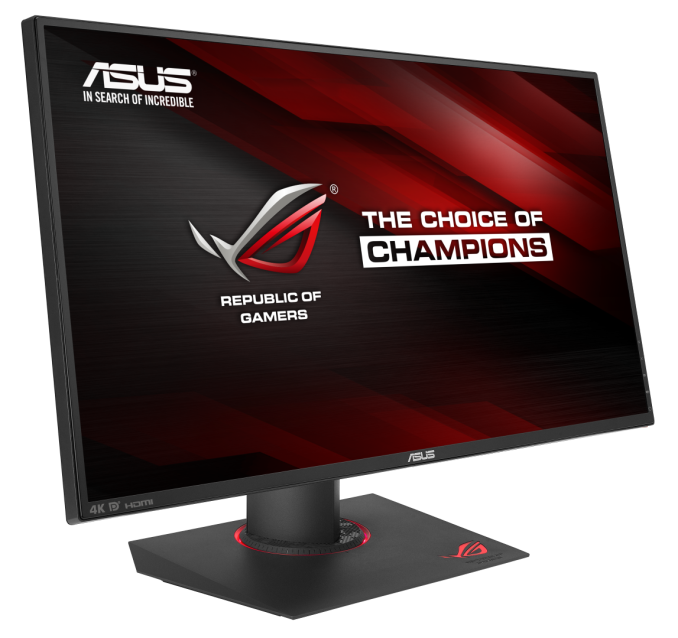ASUS Announces ROG PG279Q & PG27AQ Gaming Monitors
by Brandon Chester on October 9, 2015 6:00 PM EST
Today ASUS announced two new gaming monitors at their Republic of Gamers Unleashed event in San Francisco. Both displays are 27" IPS panels, although there are some significant differences between the two that make each one appeal more or less for certain genres of games. Below you can find all the relevant specifications for both of ASUS's new monitors.
| ASUS PG279Q | ASUS PG27AQ | |
| Resolution | 2560x1440 | 3840x2160 |
| Panel Size | 27" | |
| Panel Type | WLED + IPS | |
| Refresh Rate | 144Hz (OC 165Hz) | 60Hz |
| Contrast Ratio | 1000:1 | |
| Peak Brightness | 350 nits | 300 nits |
| Response Time (GtG) | 4ms | |
| Viewing Angle (H/V) | 178° / 178° | |
| Inputs and Outputs | DisplayPort 1.2 HDMI 1.4 2x USB 3.0 3.5mm audio |
|
| Color Depth | 16.7 million (8bit) | 1.07 billion (10bit) |
| Speakers | 2x 2W Stereo | |
| Other Features | NVIDIA G-Sync NVIDIA Ultra Low Motion Blur |
NVIDIA G-Sync |
| Price | $799 | N/A |
Starting with the PG279Q, we see that it's a 27" WQHD IPS panel with a refresh rate of 144Hz. This monitor is definitely targeted more toward gamers who play games like first person shooters where a high refresh rate is a greater asset than a higher resolution. When paired with a GTX 960 or faster NVIDIA GPU the display's refresh rate can be boosted up to 165Hz, and ASUS has even included a button on the monitor to switch between the two refresh rates on command. This is actually more useful then it sounds, because a user can easily move to 165Hz while gaming, and stick with 144Hz in typical use which will also eliminate telecine judder in 24fps video content.
As for the PG27AQ, I would imagine that gamers who play RTS and simulation games would choose it over the PG279Q for its higher resolution. It's a 27" UHD panel with a refresh rate of 60Hz, and a greater 10bit color depth than the PG279Q's 8bit color. It shares most of the remaining specifications with the PG279Q, including a contrast ratio of 1000:1, a 4ms grey to grey response time, a 178 degree viewing angle on both axis, and the inputs and outputs listed above.
Both of these new monitors feature NVIDIA's G-Sync adaptive refresh rate technology. Even on the PG27AQ this can be useful despite it only being a 60Hz panel, as it will produce a much more fluid image if a game's frame rate drops below 60fps than a non G-Sync / FreeSync display. However, only the PG279Q has NVIDIA's Ultra Low Motion Blur technology which uses a strobing backlight to reduce motion blur. It's worth noting that G-Sync and ULMB are mutually exclusive and you need to choose which one you want a game to use based on whether or not you can maintain the PG279Q's native refresh rate of 144/165Hz.
The ASUS PG279Q will be available in November, with a starting price of $799 in the United States. Pricing and availability for the PG27AQ is currently unknown, but I would imagine that the price will be in the same realm as the PG279Q.











38 Comments
View All Comments
SanX - Saturday, October 10, 2015 - link
Manufacturers are keeping harasding the common sense with midget monitors. Watch my lips: any 4k monitor must be not smaller then 48-50". For any purpose, gaming or business.brucek2 - Saturday, October 10, 2015 - link
Put another way, what you're saying is that no desktop monitor should ever be allowed to be 4K.I am glad you are not in charge of worldwide monitor production.
Gigaplex - Saturday, October 10, 2015 - link
What about 47"? Your absolute limits aren't reasonable.blzd - Sunday, October 11, 2015 - link
You use 50" TVs as a desktop monitor?User.Name - Monday, October 12, 2015 - link
3840x2160 at 22-24" is a "High DPI" or "Retina" class monitor.Text and images are rendered at twice the resolution of a standard DPI display and the quality is significantly improved. Your workspace is not 3840x2160, but 1920x1080.
4K at 40-44" is a massive "standard DPI" monitor.
You get the full 3840x2160 workspace, but the pixels are relatively large.
Text on standard 100-110 PPI monitors looks pretty bad to me after using retina-class notebooks, phones, and tablets for a few years now.
4K at 27" is an awkward display. It's too big for 2x scaling, too small to use at 1x, and non-integer scaling has a lot of rendering problems.
Frankly I'm hoping that 8K gets here sooner rather than later. It's a much more flexible resolution and will allow for "retina-class" displays in the 40-44" range (2x) and print-quality displays in the 22-29" range. (3x and 4x scale)
zodiacfml - Saturday, October 10, 2015 - link
Wow, I love these specs. Nothing to complain except that the price reflects that too. Maybe, Freesync versions will fix that.Azune - Saturday, October 10, 2015 - link
I don't get why manufactureres focus so much on higher refresh rate. 120hz is already the perfect frequency, since it is a multiple of 30 and of 24, so you won't have stutter in either video content. And even though the difference between 60 and 120 is noticeable, (nearly) nobody will notice the difference between 120 and 144, especially since most systems cannot drive a display at that refresh rate anyway.Gigaplex - Saturday, October 10, 2015 - link
Spec sheet wars.blzd - Sunday, October 11, 2015 - link
Exactly. Heck even 90 or 100Hz would be enough. Now we're getting 144 and 160 for no reason.User.Name - Monday, October 12, 2015 - link
A flicker-free 165Hz display has almost half the motion blur of a 90Hz display.6ms persistence vs 11ms.